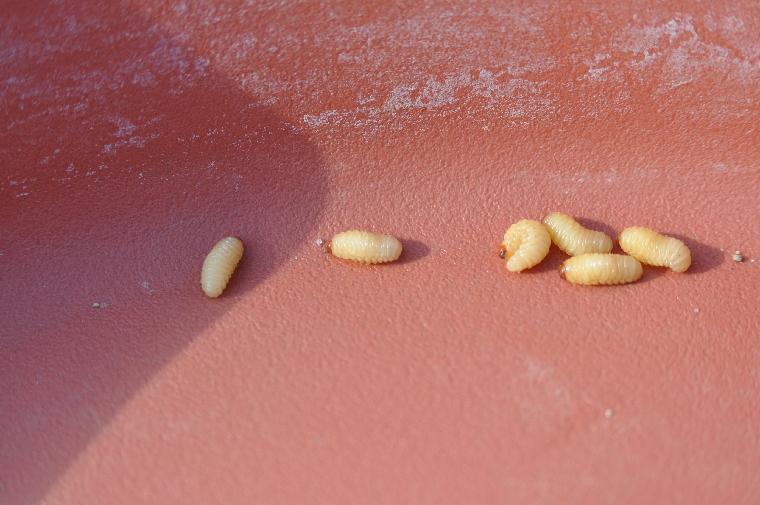I've been distracted by Chinese Chestnut season in my backyard. As a few people may know, up until about 100 years ago the eastern forests of North America where thick with native American chestnut trees. The trees were tall and straight, and their nuts were big and sweet. At least, that is what my father claimed. Then the European Chestnut Blight hit, and within a decade there were no chestnut trees left in North America. Italian chestnut trees are resistant to the blight but can't grow in North America, apparently for reasons of climate. The smaller Chinese chestnut trees are resistant and will grow here.
Chinese Chestnuts (Castanea mollissima)
We have a small nut orchard in the backyard, including 6 Chinese Chestnut trees. Three of these trees are worthless except as pollinators -- the nuts are too small to be useful and their flavor is very poor. They were, at least, very cheap when bought about thirty years ago. The other three chestnut trees produce tasty nuts of respectable size. These good trees cost more and came from a reputable commercial fruit tree nursery by mail order.
Into this seemingly idyllic picture now comes a villain -- some sort of worm. Actually, the worm is clearly the larva of some sort of fly, insect order Diptera, which have very characteristic young, commonly referred to as maggots. We can't get them identified to the species level, because I can't get the mature larvae to pupate and then produce adults. All maggots look more or less the same, it seems! These make a hole about 1/16th inch across when they emerge from the nut. The maggots themselves are about 1/4th to 5/16ths inch long as they emerge from the nuts. I assume they emerge after the nuts have fallen to the ground, and that they burrow into the ground to pupate and spend the winter. The adults almost certainly emerge sometime at or after the time the nut trees bloom in the early summer of the following year.
Since we can't identify the exact species of fly involved, we can't tell exactly when the flies emerge, mate, and lay their eggs on the young, immature nuts. For several years, we accidentally got the spray schedule just right, and we had no worms in our nuts. Then the guy who did the spraying left town, and his replacements have not yet figured out precisely when to spray the trees to prevent the worms completely. My preliminary survey of some of the harvested nuts shows a worm infestation of about 20 - 25%. It could certainly be worse, and this only applies to the first tree whose nuts ripened.
I would rather show you a picture of the adult fly, but since I can't seem to grow the worms to maturity -- I have in fact tried -- I will have to settle for a picture of the maggots. The ones pictured are alive, but I also pickled some in 70% isopropyl alcohol.

Mature larvae of nut fly (Diptera)
About 1/4 inch long
Being ignorant of the life cycle of our unidentified nut fly, I decided the spraying crew would spray just before anthesis, a second time at the end of pollination, and again later in the season. Our three useful trees ripen their fruit at 1-week intervals, the last tree ripening about two weeks after the first. I judged the time for the first spraying on the middle and last trees. We now find that the first tree to ripen has lots of worms, while the middle tree has only a very few. We can't tell for the last tree to ripen just yet.
Haemanthus (Continued)
My beloved Haemanthus have continued to bloom.
The Haemanthus coccineus have finished up except for a straggler or two. The Haemanthus lanceifolius seem to have all set seed after my pollinating attempts. The one group blooming now are the [humilis hirsutus x coccineus] hybrids.
The female (seed) parent was the hirsutus, and the male (pollen) parent was the coccineus. This cross has been discussed before in this blog, in the October 30, 2007 entry and again in the September 30, 2009 entry. I'm still very much taken with it! The color seems to be unique among Haemanthus in my experience, but I grant that I have seen very few hybrids in this genus.
The burgundy color is mainly in the bracts of the inflorescence. It gradually turns more bronze colored as the bloom ages, and I think the color is a result of adding the scarlet red (anthocyanin) pigment of the coccineus bracts to the green (chlorophyll) pigments of the hirsutus bracts. This had not occurred to me when I was making the original cross.
![Haemanthus [humilis hirsutus x coccineus] (c) copyright 2011 by James E. Shields. All rights reserved.](Haemanthus_hirsutus_x_coccineus_Nr1534D_0998_ml.jpg)
Haemanthus [humilis hirsutus x coccineus]
So far, the plants from this cross have proved to be stubbornly sterile.
You have to be a "Friend" to see my stuff in Facebook (http://www.facebook.com/ShieldsGardens). If you try to "Friend" me, be sure to drop me a note explaining who you are! If I don't recognize your name, I'll ignore the request. Don't count on my memory, because it does not work all that reliably anymore.
Good gardening, from here in central Indiana
Jim
<shieldsgardens@gmail.com>
Look up technical terms in the Glossary of Plant Biology